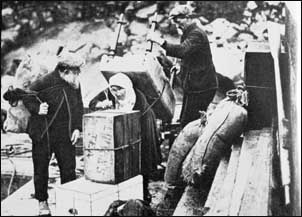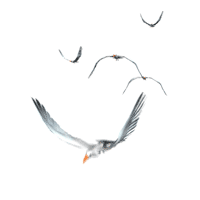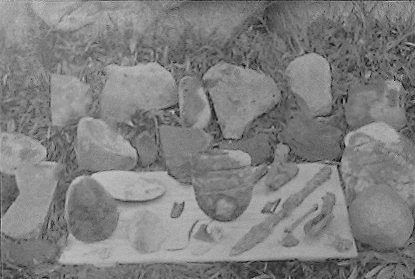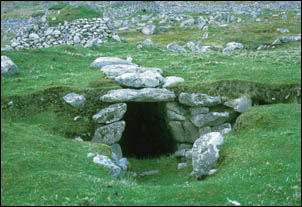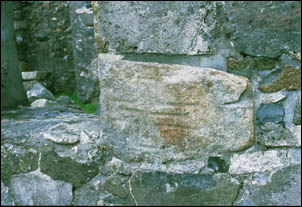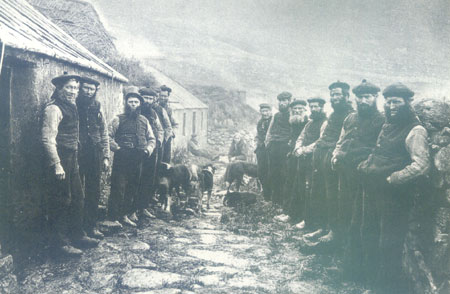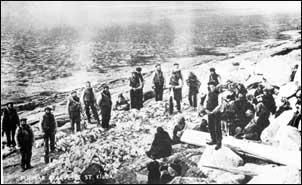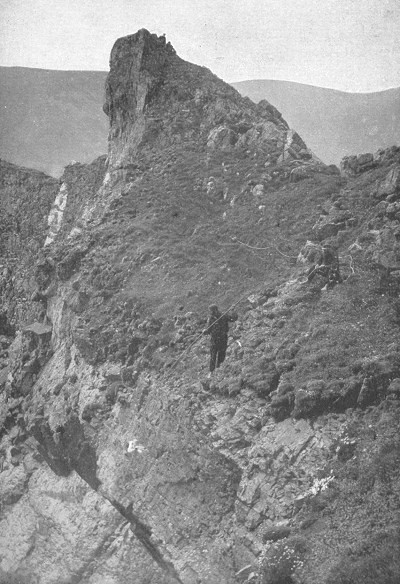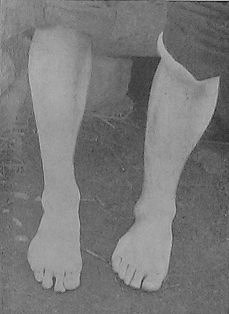Hirta .. the largest and only (once) inhabited island in
the archipelago of St Kilda. It is the most remote part of the British Isles, lying 41 miles west of the Outer Hebrides. Formed from the rim of an ancient volcano, these islands used to support a vibrant population of around 150/200 people.
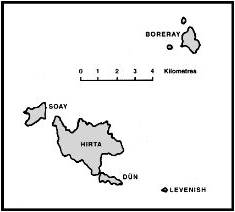
The Islanders survived predominately on seabirds nesting on the cliffs. Islanders lived in virtual isolation as the tenants of the Chief of the Clan MacLeod. As time marched forward, leaving them behind, it became a 20th century anachronism.
Victorians – many of whom had an affinity for touring asylums, prisons and the "freakish" - were fascinated by the island. They came in cruise ships to gawk at the dark-featured, taciturn men and woman that time had left behind.
On 29 August 1930, the remaining 36 islanders packed their belongings, climbed
on board the Harebell and set sail for Lochaline on mainland Scotland.
All 36 men,women & children were given new clothing for the journey, presumably
their home spun garments weren't good enough for the mainland folk.
Strangely enough the Government of the day decided that the best jobs for the
islanders would be to work for the Forestry Commission. The islanders had never
even seen a tree, the largest plant life in St Kilda was a cabbage.
Life on St Kilda had always been hard. The isolation meant that the islanders
had to work together to ensure sufficient food and clothing were available for
all. The men and women on Hirta developed their own society .. It was vastly
different for other parts of Britain, but it worked well for many years.
In this article we feature what life was like in the early days .. and what
changed the islander life, so survival on their beloved Island became impossible.
Early life on St Kilda
There have been people on St Kilda since prehistoric times. It is not clear when the first settlers came to St Kilda, but simple stone tools found on Hirta suggest that Bronze Age travellers may have visited St Kilda from the Western Isles some 4,000 to 5,000 years ago. In the 1830s the Rev Neil Mackenzie found what were probably remains of burial cists in Village Bay. Excavations in 1995 revealed a possible burial structure dating from the Bronze Age.
Some finds on St. Kilda
In 1844 an earth house, possibly a store associated with an Iron Age house dating from about 2,000 years ago, was discovered. It consists of a long passage, with shorter passages or cells branching off.
Prehistoric Earth House on St Kilda
We often think of Stone age or Bronze age man as primitive hunter
gatherer`s. However St Kilda is the remains of an underwater volcano,
therefore has never been part of the Scottish mainland. The only time
they were connected was during the Ice ages, and Scotland was unpopulated during
these.
So, how did stone/bronze age man reach St Kilda? Well on a clear
day (you don`t get a lot of them in Scotland) standing on the west shore
of Harris you can just see the outline of St. Kilda.
Could it have been possible that thousands of years ago, a stone age family
stood on the Harris shore, and with their dugout canoe, set off for the distant
land?
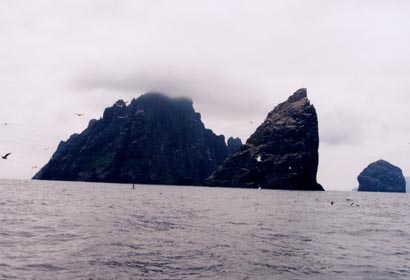
It is possible, but the question is why did they stay on St. Kilda,
even in the stone age? Life must have been easier on the mainland. One
reason that springs to mind is the difficulty people have always had landing
on St Kilda. I suppose it is possible the Stone age family`s canoe was
damaged on the rocky coastland and as there are no trees on St kilda, they would
have been trapped there.
There are records of early chapels, and two incised stone crosses of Early Christian style have been found.
Incised cross on a stone re-used in House 16
Norse occupation is confirmed by archaeological finds of brooches and steatite vessels, and by the use of Norse place names such as Oiseval - the east hill and Ruaival - the red hill.
Sadly most of the history of early years of occupation have been lost forever. Most of what we know today, of the St Kildians, comes from Victorian records.
However it is still amazing that just off the shores of the United Kingdom, on a small island, developed a culture so different, that it produced the Birdmen of Hirta.
A St Kilda fowler
Daily life on Hirta
A typical day on Hirta would start with all the men meeting in the
Main Street (the only Street) to discuss the sharing of the daily
tasks. This meeting became fondly known as the St Kilda Parliament.
This street discussions could go on for an hour or more. Finally they
would decide the various work details for each other.
The St Kilda Parliament
For example, some may sail to Soay to shear the Soay Sheep .. some
may go fowling on the cliffs, while another detail may go searching for eggs.
The men on Hirta seldom worked the fields. Digging, planting and tending
their sparse crops was the task of the St Kildian women and children.
For the complete history of life on St Kilda the people lived under the old Fudal system. Even up until the eventual evacuation in 1930 the islands were owned by MacLoud of Macloud, not only did he own the Islands but held sway over its inhabitants. Also the Islanders had to pay a rent for using the land, in St Kilda`s case the dues were paid not by money but by bartering their goods.
At least once a year Macloud of Macloud sent a representative (The Factor or Tacksman) to collect the rent. The factor would also "Purchase" any other goods, but again not for money but for items the Islanders needed .. like salt, Whisky, or seed corn. The islanders bargained with bird feathers, fulmar oil, Tweed cloth and any surplus crops.

Villagers and the Factor on St Kilda
While in this day and age this system sounds as if the Islanders were being used. Infact the system worked very well, and it was often said the St Kildan`s were the best fed and best clothed in the Hebridian islands. Macloud of Macloud was infact very generous to the Islanders, often paying a good price for their goods and supplying the Islanders with boats.
Up until the mid nineteenth century the Islanders lived in the traditional Black
House. The homes were constructed from dry stone with a roof of turf and
hay. The houses had no windows and no Chimney, the fire was in the centre
of the house, the peat smoke escaped via the door, hence everything was covered
in soot (Black House). In winter the St Kildans took their cattle indoors
with them. Leaving them outside in winter would risk the poor beasts freezing
to death. Their dung was allowed to mass on the floor and was used for
fertilizer, along with the collected soot on their fields. Although this
was unhygienic, the cattle provided the people with extra heat in the cold winter
months.
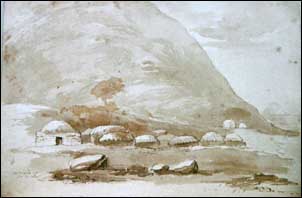
In 1829 a NEW village was built for the islanders. 25 houses, barns
and other outbuildings were constructed. This included glass and timber, two
materials unheard of in St Kilda.
There were no lavatories on St Kilda, human functions were done on the ground.
A kindly Reverend Dr Maclachlan (1850) donated a chamber pot to each household.
The Islanders were delighted with gift, unfortunately nobody told them
what they were or what their use was. The happy St Kildans used them to
cook their porridge.
The washing of dishes etc. was never done, as there was no water at hand. Plates would be cleaned on the corner of the wifes apron, Forks and knives were simply cleaned in their mouths.
The St Kildan People
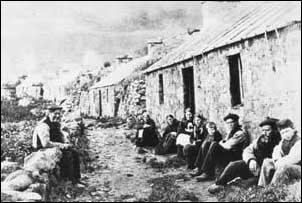
The people of Hirta were often described as "Lazy", "Fearful of strangers",
"Greedy" and even "Ignorant". Unfortunately all these descriptions come
from Victorian visitors, arriving and leaving on their pleasure steamers cruises.
The St Kildans saw only the odd fisherman or cargo boat crew, using Village
bay to shelter from the Atlantic storms. Were they really fearful from
strangers? Perhaps they were. They were fearful of the disease that they
had suffered in the past when meeting strangers.
The St Kildans were certainly not lazy. This probably stemmed from the visitors seeing the women struggling up the shoreline with delivered cargo, while the men stood and watched. This was just how St Kildans lived, Men had their tasks, and women had theirs.
St Kildan men did all the fowling, shearing, egg collecting, fishing and even
made all his family's clothes and boots. Women tended the crops, carried
the dead birds from the cliff top to the village, cooked and spun the wool into
thread.
Greedy ?... this again is completely untrue. The Islanders did not see
life the same as their visitors. If a man asked if he could take a Photograph
of a St Kildan, and then gave him a penny for his trouble. The St Kildans
then expected everyone else to pay .
One day a private yacht sailed into village bay. The owner rowed ashore
and insisted that 5 islanders go back with him to his yacht. When the
islanders boarded his boat, he showered them with cans of food and other goods,
then rowed them ashore. The following day the 5 men boarded his yacht
again, this time uninvited and wanted more gifts. The owner had to almost
throw the islanders overboard.
Greedy? .. no .. to the St Kildans this man took them to his boat .. they didn`t know why, but he paid them in goods for whatever it was. So why not go back the next day?
In truth the visitors knew very little about the Island nor the ways of the
people who lived there. The fact that few Islanders spoke English, confused
things further.
Others who came to the Island, and stayed for any length of time, got to know the islanders very well. They were a funny, generous, honest and hard working people.
Every morning, every St Kildan you met would shake your hand, and enquire if
you had a good nights sleep. If you said you had they continued on their
way, if you said you didn`t, they would ask if you had a good breakfast,
if you said yes, they carried on their way (Assuming that you had
nothing to moan about). But if you said you had a bad nights sleep and
a bad breakfast, the islander would be really concerned for you,
even offering to take back to their home for another breakfast.
In the evenings, long term visitors would be invited into someone's house. Music
from the bagpipes, songs, dancing and story telling was the custom. There
was never any drinking at St Kilda, every family owned Whisky, but it was kept
for medical purposes. All through the records kept on St Kilda, never
once was drunkenness noted.
Fowling at St Kilda
Dividing the Fulmer catch
Fowling is the act of killing Seabirds for food. St Kilda is a major seabird breeding ground, and the islanders took gannets, fulmars and puffins for food, feathers and oil, some of which they consumed themselves, the rest going to pay the rent. The birds were taken during the breeding season which lasted from about March to September. They were caught by hand, or with a fowling rod or a snare.
The St Kildan men descended the steepest cliffs with the use of horse hair ropes. The St Kildan men were expert climbers, mostly using bare feet to get more grip on the slippery rocks.
Fowling
Once a girl, whilst watching the men collect eggs on the Doon, had her petticoats ballooned by a sudden squall of wind, and was lifted clean over the cliff. She fell one hundred and eighty feet without a break, and alighted on a ledge which was covered with earth.
The cragsmen descended to pick up what they very naturally supposed to be the
dead body of the poor child, but were surprised to find that she was still alive.
Her head had entered a large Puffin burrow, and the force of the blow expended
upon her shoulders. This undoubtedly saved her, and although she hung
a whole week between life and death in an unconscious condition, she ultimately
made a complete recovery.
The St. Kildan men climbed the cliffs normally bare footed to allow them extra grip on the slippery rock faces. Thus the men of St Kilda seemed to evolve much stronger and
abnormal size of ankle joints and the thickness of their insteps.
St Kildan leg to the right.
St Kilda was and still is a major seabird breeding ground, and the islanders took gannets, fulmars and puffins for food, feathers and oil, some of which they consumed themselves, the rest going to pay their rent. The birds were taken during the breeding season which lasted from about March to September.
The Islanders consumed Puffins as snacks, almost like modern day children consume
a packet of crisps. Seabird flesh is very oily and greasy but St Kildans seemed
to develop a particular taste from this diet. When asked why they didn`t eat
much fish, one man replied "a lot of work for nothing and the flesh is to dry".
The St Kildans had a use for every part of the fulmar. The feathers, a
valuable source of income, were graded according to colour and put into sacks.
The fulmar yielded up to half a pint of oil poured directly out of the stomach,
this was bartered when the factor came. The birds that were to be preserved
for eating in the winter were split lengthways down the back and filled with
salt and then packed in barrels. The entrails of the fulmars were used
for bait for fishing and the bones thrown on the "Midden" to become fertiliser
in the spring.
Winter in St Kilda was not so much cold (St Kilda lies in the gulf stream) but wet. Stormy seas and large waves 60 to 80 feet high could cast sea spray over the hill tops and stream down the village streets. The St Kildans therefore developed an interesting way of preserving food and keeping rope and tweed dry by using stone built storage shelters known as "Cleits"
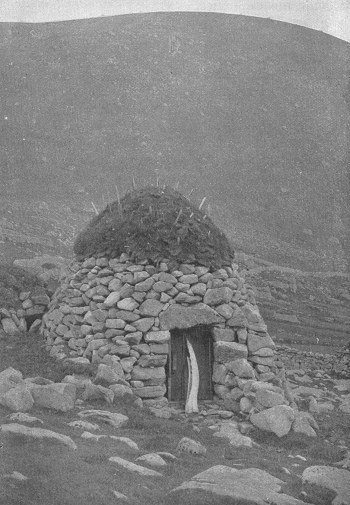
Throughout the years the St Kildan people built hundreds of these
Cleits, not only on Hirta but on neighbouring islands. The Cleit is constructed
of stone walls with a dry sod roof. On Purpose they left gaps in the wall
construction so while the sod roof kept the contents dry, the howling Atlantic
gales blew threw the Cleit walls, preserving the goods within .. almost as good
as a modern day fridge.
In 1726 an Islander left and visited Harris, He caught Smallpox and died. The people of Harris packed up his belongings and sent them back to St Kilda.
(Meanwhile on St Kilda a party of 3 men and 8 boys were sailed over to Stac an Armin (643 ft) to collect gannets. This should have mean a stay on the Stac of around a week.)
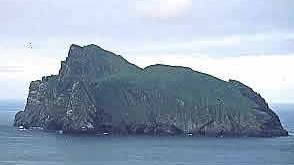
The Dead St kildans clothes sent back to his relatives were shared
out, but they contained the smallpox virus. Very quickly smallpox spread
throughout the villagers. Because of the Isolation of St Kilda it took
nine months for word to arrive and rescue to arrive. In the Hirta village
only one adult and eighteen children survived.
Some of the rescuers rowed a boat over to Stac an Armin, and were surprised to discover the three men and 8 boys were alive and well.
The owner of St Kilda had to send people from Harris to repopulate St Kilda. These people soon developed into Cragsmen with help and instructions from the original survivors.
Regardless of who did what on St Kilda, everything was shared out equally per
head of house. Say one house had two people and another had eight, the
shares of the catch would be divided and one house get two shares the other
eight. This sharing was the only way that St Kildans could survive. Every
man, Woman and child worked for their village.
The Beginning of the End
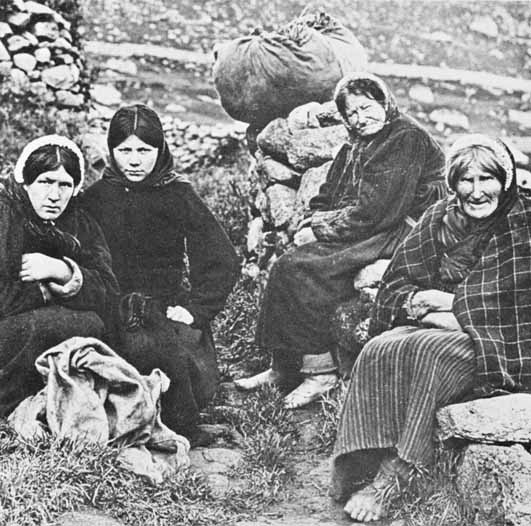
In the Victorian times people began to see just how hard a life the St Kildans lived. People could not understand why the people put up with such hardship, and tried to change their way of life, make it more like the mainland.
Life in St Kilda would change forever. Feathers once used to stuff army
pillows and mattresses were no longer in great demand. Fulmer oil was
not in use so much for lighting and their bales of Tweed barely made any money.
MacLoud of MacLoud knew of this and dramatically lowered the Island rent. The
People started taking an interest in Religion. The Free Church of Scotland
enslaved the people of Hirta.
Sure you might think that the Free Church`s teaching would be a good thing,
The Minister prayed for everyone on Sunday, his wife ran the schoolroom and
brought education to the villagers. Sadly, the people of St Kilda throw
themselves headlong into their tasks, and now they threw themselves into Religion.
The strict Free Church demanded that come the darkness of Saturday, nothing more would be done till light on Monday .. That was the Sabbath. All you could do on the Sabbath was go to Church ... sermons of 2 hours long, three times on Sunday, and all were to attend even the sick and frail.
Hirta descended into Chaos. All the children now attended school through
the week. They no longer helped in the fields, or carrying the fulmar
catch down to the village. All St Kildans lost work time for the Sabbath.
Boats that arrived with vital supply's on a Saturday had to stand off shore
until Monday. Week long trips to other Islands or Stac`s no more.
The people once so happy with life, now walked with long faces and talked in
whispers. Life got so bad on the Island that the younger people started
to leave, and find work on other islands or the mainland. The less people,
the less birds collected, the less birds collected, the less food to eat.
Slowly it became Impossible to carry on life on the Island. The elder
St kildan`s wanted to stay, but the younger ones refused. On 29 August 1930,
the remaining 36 islanders stepped off the Island for the last time,and as St
Kilda vanished beneath the mist, a race of special people had gone.
